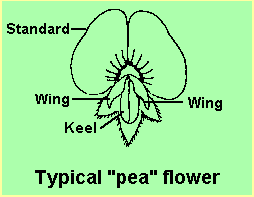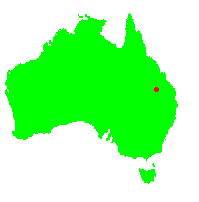General Description:
Swainsona is a genus of about 80-90 species with the most famous member being Sturt’s desert pea (Swainsona formosa), one of Australia’s most spectacular wildflowers. All members of the genus are found only in Australia, usually in semi-arid and arid areas.
Swainsona sejuncta is closely related to the widespread and well known species S.galegifolia. S.sejuncta is a sub-shrubby perennial reaching about 1 metre high by 1.5 – 2 metres across. Leaves are pinnate to 15 cm long with 19-31 leaflets.
 The typical “pea” flowers consist of 4 petals; the “standard”, the “keel” and two “wings”, as shown in the diagram. Flowers occur in racemes 10-15 cm long and flower colour is variable – either yellow with brown or orange or white and partly pink or all pink. Flowers are seen mainly in spring. The inflated seed pod is about 3 cm long – the seed makes a rattling sound when the pods are shaken. It grows in sandy-clay loam or basalt soils in eucalypt forests.
The typical “pea” flowers consist of 4 petals; the “standard”, the “keel” and two “wings”, as shown in the diagram. Flowers occur in racemes 10-15 cm long and flower colour is variable – either yellow with brown or orange or white and partly pink or all pink. Flowers are seen mainly in spring. The inflated seed pod is about 3 cm long – the seed makes a rattling sound when the pods are shaken. It grows in sandy-clay loam or basalt soils in eucalypt forests.
This species is not known in general cultivation although plants have been growing for a number of years at the Mount Annan Botanic Garden in south-western Sydney. The plant appears to be very hardy under conditions at Mt Annan. However, there is some concern that the species may be a weed risk if culticvated outside of its natural range. The paper “Swainsona sejuncta: a species of ornamental promise or a potential weed? by A. Martyn, J. Tyler, C. Offord and R. McConchie concludes that “…..if S.sejuncta naturalises outside its limited native range in the future, then the species would be considered to have a high weed potential. ……. Consequently, cultivation and commercialisation of S.sejuncta as an ornamental plant is not recommended without further research.”
Propagation is likely to be relatively easy from seed following pre-treatment with boiling water (similar to other members of the pea family). Cuttings should also strike reasonably readily.
* EPBC Act = Environment Protection and Biodiversity Conservation Act 1999;
ROTAP = Rare or Threatened Australian Plants (Briggs and Leigh, 1988)
For further information refer the Australian Plants at Risk page

Swainsona sejuncta
Photo: Brian Walters
 Australian Native Plants Society (Australia)
Australian Native Plants Society (Australia)